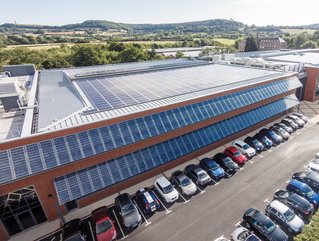Managing energy use to reduce carbon footprints

According to National Grid, more of Britain’s electricity production will come from zero carbon energy sources than from fossil fuels in 2019 — the first time since the Industrial Revolution. This is positive progress towards the UK Government achieving net zero carbon emissions by 2050. Here Ben Goodare, Corporate Social Responsibility Manager at global engineering technologies company, Renishaw, shares the changes businesses can make on their energy management journeys.
When reviewing your energy consumption as a business, the first step is to look at your total energy footprint and focus on reducing the amount of energy needed. You can speak to your energy suppliers to find out how much you are using.
Identify areas for change
Firstly, identify how much energy you are using when the facility is not in operation by establishing a baseload. By conducting spot checks, for example over the weekend, you can identify if equipment is left running when it could be turned off. You can then think about making building refurbishments to reduce other energy waste, such as adding double or triple glazing or insulation. Switching to LEDs or placing lights on movement sensors can further reduce energy usage.
Renishaw undertook major refurbishments to improve its energy efficiency after purchasing a new facility near Miskin, South Wales. Switching to high-efficiency air conditioning, adding insulation and removing inefficient boilers, the company was able to reduce gas consumption from the site by almost four times.
Manufacturers and engineering businesses can also examine machinery efficiency. Renishaw found that reprogramming its machine tools to automatically enter an emergency stop mode when not in use, rather than standby, saved nearly a million kilowatt hours of electricity a year. Proactive maintenance can also save on energy, particularly when working with compressed air or other energy intensive processes.
Once you have established a baseload, you can assess how much energy the business is using when the facility is in operation. Making building management rules, such as turning the air conditioning off before 5pm and over the weekend, can lead to big savings. An energy management software tool can help you to map this to monitor usage more easily.
SEE ALSO:
-
How Requis is revolutionising supply chain management in the energy sector
-
Managing operational risks is key to improving sustainability
Involve your staff
Armed with data about your facility, you can then discuss the issue with your employees. In an engineering company, your engineers will have a good understanding of manufacturing processes and may be uniquely placed to identify areas for improvement. Renishaw has an active suggestion scheme and Yammer group, where staff can contribute their ideas. You could even incentivise employees with rewards for coming up with energy saving ideas.
The next step is to establish where you could sensibly generate your own energy. Renishaw’s self-generation has increased 64% since 2018 and the solar panels at its headquarters site, New Mills, have an annual generation capacity in excess of 1.2mn kWh. The company has also installed solar panels in India, and at three other UK manufacturing sites. The company will also be installing them at a new site in the USA, and is exploring options in Mexico, Ireland and Italy. Because space can limit the number of potential solar panel installations, together with unique features of different locations, hydroelectric and wind power are also options that are being explored.
Finally, you can look at sourcing renewable energy. Renishaw has found success doing this — 80% of its electricity consumption globally and 98% of UK electicity is from renewable sources.
Zero carbon by 2050 is the target identified by the UK Government for the country. To support the achievement of this target, businesses can look for ways to decrease their overall energy usage, self-generate and turn to renewable sources. This approach has enabled Renishaw to reduce its total absolute greenhouse gas emissions by 35% since 2015, but there is a long way left to go.
Ben Goodare is Corporate Social Responsibility Manager at global engineering technologies company, Renishaw.






